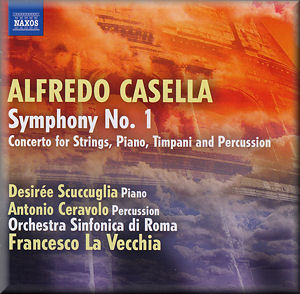 |
 |
|


alternatively
CD: MDT
AmazonUK
AmazonUS
Sound
Samples & Downloads
|
Alfredo CASELLA
(1883-1947)
Symphony No.1 in B minor Op.5 (1905-06) [44:46]
Concerto for strings, piano, timpani and percussion Op.69 (1943)
[21:35]
 Desiree Scuccuglia (piano); Antonio Ceravolo (percussion)
Desiree Scuccuglia (piano); Antonio Ceravolo (percussion)
Orchestra Sinfonica di Roma/Francesco La Vecchia
rec. April 2009, Auditorium Conciliazione, Rome (Symphony); October
2008, OSR Studios, Rome (Concerto)
 NAXOS 8.572413 [66:22]
NAXOS 8.572413 [66:22] 
|
|
|
Well, who knew? Who knew, despite the composer himself retrospectively
complaining that his youthful First Symphony was a ‘Russian-Brahms-Enescu’
compound, that it was so enjoyable? It was completed when Casella
was twenty-three, in 1906, but other than noting this post-facto
writing-off, we can still listen to it with considerable pleasure.
Certainly there are Tchaikovskian elements at play and Mussorgskian
ones too, most obviously in the more glowering moments of the
first movement. But the brisk march theme that is also at work
here is finely orchestrated, and fits in well thematically.
In fact Casella couldn’t have disliked this symphony as
much as he claimed because he liked the slow movement enough
to recycle it in this Second Symphony - he could do so with
impunity because the earlier work hadn’t been published.
It’s warm, lyrical, sharing something of Rachmaninoff’s
approach, though there are Balakirev intimations as well. The
pounding apex of this movement, with percussion throbbing, is
exciting - the tawny brass is also in its element.
Like the opening movement the finale begins with an intense
Lento section - oddly sounding a touch like Vaughan Williams.
Then we move off into Brucknerian waters. I realise I am actually
playing Casella at his own game and suggesting influences, though
obviously at least two of the composers cited can’t have
been influences on Casella; this is more in the way of trying
to suggest what the music actually sounds like. The finale is
the most laden, and perhaps in some ways the most intriguing
movement. I liked its open air sections, but I also liked its
Parsifalian March element too.
So, this is an exciting discovery of a symphony that bears strong
traces of late Romantic influence but which is very well orchestrated
and manages for quite a bit of the time to absorb those influences
to the general good.
The companion work is a very different affair, the Concerto
for strings, piano, timpani and percussion Op.69 of 1943. It’s
best here to think of contemporaneous works by Honegger and
Martinů. The neo-baroque motor is strong and resilient.
There’s a powerful Sarabande majoring in coiled lyricism;
and then there’s a bristling finale, with brusque writing
for the most part but an almost disquietingly quiet and unresolved
ending. School of 1943, then - though, as we know, Casella’s
position in Mussolini’s Italy was, and remains, highly
controversial.
The entertainingly written booklet notes set the seal on an
exploratory release that provides the First Symphony with its
first ever recording. The Orchestra Sinfonica di Roma under
its stylistically acute conductor Francesco La Vecchia plays
with whole-hearted conviction and the performances, recorded
in two locations six months apart, have been well engineered.
There are two sides to Casella here; the striving, romance-hungry
young man weaned on Bruckner and Tchaikovsky and similarly rich
milk; and the terse, increasingly astringent older man, searching
for verities in the neo-baroque amidst the tumult of war.
Jonathan Woolf
see also review by Dan
Morgan
|
|

